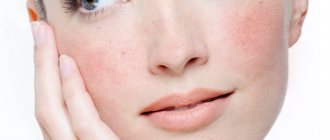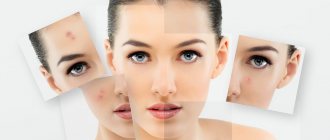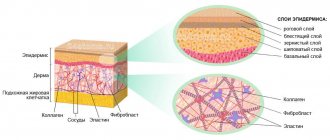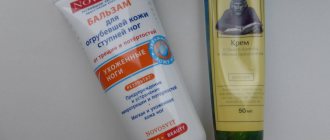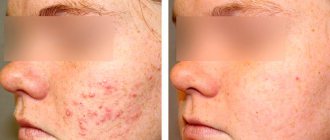- Acne treatment
- Rosacea Treatment
- Treatment of demodicosis
“ Subcutaneous mite ” sounds very unpleasant, and many may think that anyone can get this parasite, but “but not me.”
In fact, demodicosis - this is the name given to damage to hair and skin areas by a microscopic mite - is far from a rare phenomenon. And some cosmetic procedures can provoke an exacerbation.
Scientific fact: human skin can be parasitized by 2 types of Demodex , which feed on dead skin cells and live on the skin and hair follicles, including eyelashes and eyebrows:
- brevis;
- folliculorum.
As a result of their activity, a person feels itchy skin, redness, peeling appear, and the skin becomes rougher. If measures are not taken, all these unpleasant symptoms can develop into crusts and inflammatory elements.
Causes of exacerbation of demodicosis
- various types of dermatitis;
- weakened immune system;
- acne;
- skin infections;
- HIV;
- gastrointestinal diseases.
To treat the disease, you must consult a doctor. Self-medication in this case is evil. The doctor will conduct an appropriate study and prescribe adequate therapy.
Concept
Doctors say that demodicosis is not a separate disease, but a condition of the skin. This is justified by the fact that subcutaneous mites are present in every person, and this is considered the norm.
Doctors even expressed the opinion that the presence of these microorganisms in a passive state has a beneficial effect on the health of the skin, since they are able to maintain a normal microbial biocenosis and block the proliferation of pathogenic microorganisms.
Their function is also to maintain the acid-base balance, which is a kind of protection of the skin from adverse environmental influences.
How to get rid of acne quickly
Acne is a common skin problem, affecting about 85 percent of the population.
Under certain circumstances, active development and reproduction begins. Waste products are released into the pores, this causes the development of an inflammatory reaction.
The lifespan of a subcutaneous mite is 15-25 days, after which it dies and decomposes. This provokes the appearance of acne, pimples and blackheads.
If timely diagnosis is carried out at an early stage, the risk of developing acne from subcutaneous mites is minimized. This is especially important if you have a low immune system.
What procedures provoke an exacerbation?
Even after treatment, the skin is vulnerable to external influences, not to mention skin that has not undergone therapy, since its protective functions are significantly reduced. As noted earlier, other exacerbation factors include some cosmetic procedures:
- phototherapy and laser coagulation - these procedures help to increase temperature and increase blood flow to the skin, and at the same time increase the production of sebum (and this is simply an ideal environment for subcutaneous mites);
- massages, vaporization, ultraviolet exposure (in a solarium, for example) - also contribute to increased sebum production, and therefore should be excluded from the list of procedures until remission is achieved;
- chemical peeling - in the acute stage of the disease, aggressive acids only contribute to the proliferation of mites, however, this procedure is sometimes effective in combating residual effects on the skin (everything is very individual);
- Skin biorevitalization is one of the most popular anti-aging procedures, but during periods of exacerbation of the disease it is contraindicated.
Demodectic mange or subcutaneous mite
Details Category: Interesting articles Date of publication
Demodicosis is a dangerous disease that everyone should know about. Demodectic mange is caused by subcutaneous mites and causes significant deterioration of the skin condition. It is important to recognize this disease as early as possible, since in the early stages it is much easier to cure.
What is a subcutaneous mite
Subcutaneous mites on the face are caused by Demodex or Iron Acne. This is a small arthropod that lives in the sebaceous glands and hair follicles of humans. Its size varies from 0.1 to 0.4 mm. Normally, it is present in every person - no more than 2-3 individuals per square centimeter. In small quantities, the mite does not cause any harm to the body; on the contrary, it serves to maintain the normal acid-base balance of the skin. But when exposed to certain factors, the mite begins to actively multiply, and this leads to pronounced negative changes in the skin of the face.
Symptoms of the disease:
acne;
greasy shine;
skin redness;
itching;
nose enlargement
Since demodicosis disrupts the normal functioning of the skin, its characteristic feature is a constant oily sheen on the skin. The face always seems to be in a greasy shell, and no amount of washing removes these sensations. Increased oiliness of the skin without a reason is often the first manifestation of subcutaneous mites.
A malfunction of the skin causes the formation of numerous rashes (they are also called “tick pimples”), acne, and later ulcers. The skin looks lumpy. Redness, which is one of the first symptoms of a tick-borne infection, worsens as the disease progresses.
Itching becomes a constant companion for such patients. The fact is that the waste products of “facial” mites cause an allergic reaction, causing the face to itch and itch. Some people feel as if they can actually feel the mites moving around in the top layer of their skin. Symptoms worsen at night. During the day, the activity of subcutaneous mites is much lower, this is due to the fact that Demodex is afraid of light.
If a tick settles in the nose area, the organ tissue is replaced with connective tissue, causing the nose to become larger and fleshier. Part of the skin thickens and becomes crusty.
The unpleasant presence of “sand” is constantly felt in the eyes; they turn red and watery.
These symptoms do not appear immediately. By identifying the disease at an early stage and managing to cure it, it is possible to prevent the most unpleasant manifestations of demodicosis.
Stages of development of demodicosis
There are several stages in the course of the disease.
Prodromal period
At the first stage, the disease manifests itself still implicitly, it does not cause severe discomfort, and therefore often goes unnoticed. But it is the first stage that is the most important for identifying the disease. At this stage, it is still possible to prevent the further development of demodectic mange if you start treatment of the facial skin in time.
At the initial stage of demodicosis, redness appears on the skin, and they have clear boundaries and differ from normal redness of the skin. During the prodromal period, it is easy to trace the reasons that provoke the formation of redness. Most often this is: drinking alcohol, salty or spicy foods.
If you identify the cause of redness, that is, the proliferation of demodex on the face, and limit the impact of the harmful factor, the disease will bypass you. If this cause is not identified and eliminated, the disease will develop further. Treatment of demodicosis at the initial stage significantly increases the chances of a complete and rapid recovery.
Erythematous period
At this stage, redness becomes more and more pronounced and occurs for no apparent reason. At this stage, it is still possible to successfully fight the disease using medications.
Papulopustular stage
Nodules begin to form on the skin, which then develop into papules and ulcers.
Hypertrophic stage
This is the last stage of the disease, which is accompanied by the appearance of pineal growths on the face, thickening of the skin and the appearance of large ulcers. Treatment
Diseases at this stage are very complex, even with the most modern medications and procedures. Never delay treatment of demodicosis!
Diagnosis of the disease
To identify demodicosis, you need to scrape the skin and eyelashes to determine the number of individuals on the face. If a tick is found on the face, or rather, it turns out that there are more than 5 of them per square centimeter, then a positive diagnosis will be made and drug treatment will be prescribed.
Before submitting the scraping, you will have to refrain for several days from using decorative cosmetics, creams, lotions and medications to combat the parasite.
Causes of subcutaneous mite activity
There are many reasons for the activity of the subcutaneous mite and, as a rule, it is quite difficult to identify them, since the same conditions cause demodectic mange in one person, while another person retains ideal skin.
To prevent the spread of mites, follow general hygiene rules and regularly care for your facial skin. The main reasons causing the proliferation of subcutaneous mites:
reduced immunity;
disruption of the digestive system;
excessive alcohol consumption;
too frequent visits to the bathhouse, beach or solarium;
coffee abuse;
low quality cosmetics;
The development of demodicosis is also influenced by concomitant diseases, all kinds of infections, dysfunction of the endocrine glands, stomach ulcers, diabetes, etc. The disease manifests itself only against the background of reduced immunity, so it is necessary to constantly strengthen it.
Treatment of demodicosis
Treatment of demodecosis must be carried out by a specialist after a laboratory examination.
Diet for demodicosis
Treatment of demodicosis must be comprehensive, so you must follow the rules in nutrition. During therapy, it is necessary to limit, or better yet completely avoid, foods high in sugar, smoked, fatty and spicy foods, as well as coffee and alcohol.
. For demodicosis, it is recommended to include in the diet:
porridge;
bran;
products made from wholemeal flour;
vegetables;
dairy products.
Head of the Morshansky branch, dermatovenerologist G.A. Varcheva
What then is possible?
To begin with, we should say what is needed - a dietary regimen during and after treatment. What about cosmetic procedures? Some of them are a real salvation in the fight against demodicosis. They help restore infected areas of the skin:
- cryotherapy - cold exposure, causing a sharp spasm of blood vessels followed by persistent dilation; result - peripheral blood supply is enhanced, skin nutrition is improved, metabolic processes are accelerated, the immune system is activated, and the skin's resistance to stress increases;
- mesotherapy - carried out during the period of remission, this is an injection procedure, the essence of which is the delivery of restorative substances contained in the preparations / cocktails to the tissues;
- plasma therapy - carried out during the period of remission, this is the introduction of purified and platelet-rich blood plasma of the patient into the affected areas of the skin; As a result, skin immunity is stimulated, and regeneration processes are launched at the cellular level.
Each of the procedures described above is prescribed in a course; to achieve a sustainable effect, on average, 5–6 procedures are required, which are carried out every 7 days.
Causes of the disease
The demodex iron mite has a strong protective shell, thanks to which it is very stable, making the treatment process quite complex and time-consuming. The main causes of demodicosis in humans are:
- weak immunity;
- diseases of the gastrointestinal tract;
- metabolic disease;
- hormonal imbalances;
- long-term use of corticosteroid ointments;
- stress;
- problems with lipid metabolism;
- mental illnesses;
- lack of hygiene;
- ecology.
Studies have shown that this disease occurs more often in women with thyroid problems and in men with prostate adenoma.
Diagnostics
If characteristic symptoms occur, there is a need to conduct a full diagnosis. To do this, it is necessary to take a biological sample and carefully examine it under a microscope.
7 days before taking a sample, the patient must exclude all cosmetics from use; for hygiene, alkaline products can be used.
Sample collection is carried out in the following ways:
- Scraping the skin in the affected area.
- Examination of eyelashes taken from a patient.
- Fixation with a special transparent adhesive tape, which is subsequently removed and viewed under a microscope.
When diagnosing demodicosis, there is a need to visit an ophthalmologist, since the mite can develop on the eyelids and eyelashes, which can adversely affect vision. If inflammatory reactions are observed on the eyelids, the specialist will prescribe special medications that protect the eyes from the parasite.
Analysis for demodicosis
Laboratory testing is a necessary step for correct diagnosis of the disease.
The collection of material for research (scraping) is performed by a medical professional using a special spoon or scalpel. The resulting tissue fragment is placed in a special solution, previously applied to a glass slide, then examined under a microscope for the presence of mites, as well as their larvae and eggs. If there are no living individuals and embryos, but empty egg shells are found, a re-examination is required.
In order for the demodex test to be reliable, the patient must follow some preparatory rules for a week.
- Don't wash your hair.
- Do not use cosmetic products.
- Do not apply medicinal preparations.
Prevention
To avoid the development of demodicosis or to prevent its secondary occurrence, it is necessary to follow basic rules of prevention.
In addition to a healthy diet, experts recommend the following activities:
- Avoid close contact with infected people.
- Lead a healthy lifestyle .
- Observe the rules of basic hygiene measures.
- Use only high-quality cosmetics.
- Timely treatment of diseases of internal organs.
- a dermatologist immediately if you notice skin changes.
- Take the vitamins and minerals your body needs.
- Change bed linen at least once a week.
You need to know that the active activity of the subcutaneous mite adversely affects not only health, but also the appearance of a person, since a face affected by demodex looks at least unaesthetic.
Symptoms
The primary symptom of parasite activity is redness of the skin of the face, and not necessarily the presence of acne. Since the subcutaneous mite is so small, it is not so easy to see. It is necessary to pay attention to the presence of the following signs:
- The appearance of itching , the sensation of “crawling goosebumps” - a similar phenomenon occurs as a result of an allergic reaction to the decay products and vital activity of the parasite. The symptom worsens after washing.
- Dilation of blood capillaries on the surface of the skin.
- Peeling of the skin.
- The appearance of small bubbles .
- The appearance of pimples, pustules , acne - occurs as a secondary infection due to the constant presence of an irritant. In advanced stages, acne can develop into purulent abscesses. Squeezing out formations leads to the spread of the pathogen.
- loss in affected areas.
- Unhealthy shine of the skin - appears due to the increased work of the sebaceous glands.
- Redness of the skin is observed due to the development of inflammation. If at this stage the patient does not receive the necessary therapy, then the skin in these places becomes uneven and bumpy.
- Deformation of the nose is observed against the background of the degeneration of healthy tissue into connective tissue.
- Swelling of the eyelids.
- Loss of eyelashes, in advanced stages they stick together in the morning.
- Increased lacrimation , discharge from the eyes, inflammation of the conjunctiva.
How to get rid of acne marks
Facial rashes are a common problem that almost every person faces.
If such signs appear, it is necessary to consult a doctor; prescribing the correct treatment will make it possible to avoid the development of serious pathologies and will not lead to a noticeable deterioration in the condition of the skin.
However, you need to remember that stopping the activity of the subcutaneous mite is not so easy and it will take a lot of time and effort.


